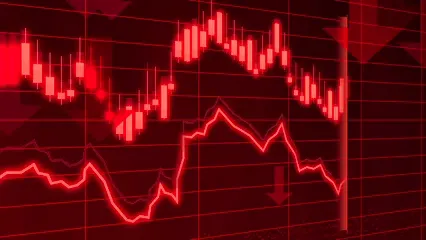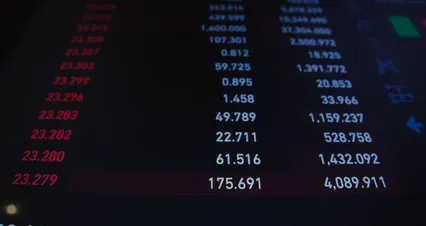Introduction
The Dow Jones Industrial Average (DJIA) serves as the heartbeat of the stock market, functioning as a barometer of economic health. This index, often dubbed the “Dow,” comprises 30 of the most significant publicly traded companies in the United States. But what insights does the Dow Jones chart provide?
Picture this: you’re at a party, and someone brings up the Dow. Suddenly, everyone has an opinion. Is it up? Is it down? Was that a record high? Understanding the Dow Jones chart is like having the secret menu at your favorite café—it’s the key to making informed decisions.
The DJIA has a rich history, dating back to 1896 when Charles Dow first introduced it. The chart tells a story, showcasing how the index has evolved over time through various economic cycles. From the Great Depression to the tech boom, the Dow’s performance reflects broader economic trends. If you want a deeper dive into stock market wisdom, check out “A Random Walk Down Wall Street” by Burton G. Malkiel. It’s like a GPS for your investment journey!
In this guide, we’ll break down the elements that make up the Dow Jones chart. We’ll discuss its historical performance, current trends, and what all this means for your investment strategy. Whether you’re a seasoned investor or just dipping your toes into stock market waters, understanding this chart can provide invaluable insights.

Curious to know how the Dow behaves in different market conditions? We’ll navigate through the peaks and valleys, revealing the secrets hidden within the lines. So, grab your financial compass, and let’s embark on this enlightening journey through the highs and lows of the Dow!
Summary of Key Points
In this article, we explore the following key aspects of the Dow Jones chart:
- Historical Context: A brief overview of the DJIA’s origins and its evolution over the years.
- Current Performance: Insights into the latest market data, including current values, changes, and volatility.
- Technical Analysis: How to read the Dow Jones chart, including chart types, key indicators, and patterns.
- Major Influences: What drives fluctuations in the Dow, including economic indicators, market sentiment, and geopolitical events.
- Investment Strategies: Practical tips for utilizing the Dow Jones chart in your investment decisions.
- Future Outlook: Predictions and trends based on historical data and current market conditions.
Curious about how to interpret the fluctuations of this iconic index? Stay tuned!

Historical Context of the Dow Jones Chart
Origins of the DJIA
The Dow Jones Industrial Average (DJIA) made its debut in 1896, thanks to the brilliance of Charles Dow. This index was initially composed of just 12 companies, reflecting the industrial backbone of the American economy. Think of it as the original influencer of stock market indices. Dow aimed to provide a simple average of stock prices to gauge market trends. The early purpose of the DJIA was to offer investors a straightforward way to track the performance of leading industrial companies. It quickly became the go-to metric for assessing the health of the U.S. economy.

Evolution Over the Years
Over the last century, the DJIA has undergone significant transformations. From its humble beginnings, it grew to include 30 of the largest publicly traded companies, representing various sectors of the economy. Major milestones include the stock market crash of 1929 and the subsequent Great Depression, which shook investor confidence. Fast forward to 2008, when the financial crisis sent shockwaves through global markets. Each of these events left a lasting impact on the DJIA, shaping its trajectory and influencing investor behavior. For those who want to understand investment psychology, consider reading “The Psychology of Money” by Morgan Housel. It’s a game-changer!
The DJIA has also adapted to changing economic landscapes. For instance, in 1928, the index transitioned from a price-weighted average to a modified price-weighted index, allowing for better representation of larger companies. This shift didn’t just change the numbers; it changed the game. The index has continually evolved, reflecting the changing tapestry of the American economy.
Charting the Past
Understanding the past requires visualization. The Dow Jones chart captures decades of market data, allowing investors to identify significant trends and patterns. Historical data is plotted to show fluctuations in the index, revealing peaks and troughs that correspond with economic cycles. For example, the DJIA soared during the post-World War II economic boom, only to plummet during the oil crisis of the 1970s.

Analyzing these charts provides insights into market sentiment and investor behavior over time. Notably, the chart reveals cyclical patterns, such as bull and bear markets. Observing these trends helps investors make informed decisions about their portfolios. The DJIA chart is more than just lines and numbers; it tells the story of an evolving economy, reflecting triumphs and challenges alike.
By studying the historical context of the DJIA, investors gain a deeper understanding of market dynamics. The index serves as a reminder of how economic events shape investor behavior and market performance. As we continue to analyze the DJIA, we uncover valuable lessons that can guide future investment strategies.
Understanding the Dow Jones Chart
Types of Charts
When you step into the world of stock trading, charts become your best friend. They’re like the GPS for navigating market movements. Let’s break down three popular types of charts: line, candlestick, and bar charts.
Line Charts are the simplest of the bunch. They connect closing prices over time, creating a smooth line. They’re great for spotting overall trends but can miss out on daily price fluctuations. Perfect for those who like to keep it simple!
Candlestick Charts add a bit of flair. Each “candlestick” shows the open, close, high, and low prices over a specific time frame. The body of the candle indicates whether the price went up or down. These charts offer more detail and can signal market sentiment. A green candle? Bullish! A red candle? Bearish! Just like your mood after a long day at work! If you’re interested in learning more about charting, grab a copy of “Candlestick Charting For Dummies”. It’s a great starting point!
Bar Charts are like candlesticks but without the color coding. Each bar represents the open, high, low, and close prices. They provide more information than line charts but are less visually appealing than candlestick charts. Think of them as the practical, no-nonsense friend at a party.

Each chart type has its pros and cons. Line charts are easy to read, but they lack detail. Candlestick charts offer valuable insights but can be overwhelming for beginners. Bar charts strike a balance, but their simplicity can sometimes be deceiving. Choosing the right chart depends on your trading style and comfort level.
Key Technical Indicators
Now that you’ve picked your chart type, it’s time to add some spice! Enter technical indicators. These nifty tools help traders make sense of price movements. Let’s focus on three key indicators: moving averages, Relative Strength Index (RSI), and Moving Average Convergence Divergence (MACD).
Moving Averages smooth out price data to identify trends. The two most common types are the simple moving average (SMA) and the exponential moving average (EMA). The SMA calculates the average price over a set period, while the EMA gives more weight to recent prices. Using these averages can help you spot trends—like recognizing when it’s time to buy that trendy sweater on sale!
Relative Strength Index (RSI) measures the speed and change of price movements. Ranging from 0 to 100, an RSI above 70 indicates an overbought condition, while below 30 signals oversold. Think of it as your market therapist, advising when to jump in or take a step back from the frenzy.

Moving Average Convergence Divergence (MACD) is another powerful indicator. It shows the relationship between two moving averages of a security’s price. When the MACD crosses above its signal line, it’s a bullish sign; when it crosses below, it’s bearish. It’s like having a financial crystal ball, helping you predict potential market moves.
Applying these indicators to the Dow Jones chart can enhance your trading decisions. They can signal entry and exit points, helping you navigate the market like a pro! And if you’re looking for more insights on trading strategies, consider “Trading for a Living” by Dr. Alexander Elder. It’s a must-read for aspiring traders!
Chart Patterns to Watch
Patterns! They’re not just for your grandmother’s quilts. In the Dow Jones chart, specific patterns can indicate potential market movements. Let’s take a look at some popular ones: head and shoulders, double tops, and double bottoms.
Head and Shoulders is a classic reversal pattern that indicates a change in trend. It consists of three peaks: a higher peak (the head) between two lower peaks (the shoulders). If you spot this pattern, it might be time to rethink your bullish stance.

Double Tops and Bottoms are also crucial patterns. A double top appears after an upward trend and signals a potential reversal. Picture two peaks at similar price levels—this is a classic sign that the market might be ready for a downward shift. Conversely, a double bottom indicates a bullish reversal after a downtrend, resembling two troughs at similar price levels. When you see this pattern, it’s like spotting a rainbow after the storm—it could signal a brighter market ahead!
Understanding these chart patterns can be your secret weapon in forecasting market movements. They provide insights into potential trend reversals, allowing you to make more informed trading decisions.
In summary, mastering the Dow Jones chart involves understanding various chart types, utilizing key technical indicators, and recognizing chart patterns. With this knowledge, you can navigate the market with confidence and flair. So, get your charts ready and start spotting those patterns!

Investment Strategies Using the Dow Jones Chart
Short-term Trading vs. Long-term Investing
Investing strategies can feel like choosing between a sprint and a marathon. Short-term trading requires quick thinking and swift moves, while long-term investing is about patience and endurance. Understanding the Dow Jones chart can enhance both strategies.
Short-term traders often analyze the Dow chart for rapid price movements. They focus on patterns, trends, and key indicators. For instance, day traders might look for breakout patterns or support and resistance levels. Identifying these can help capitalize on quick price changes.
Here are a few tips for day trading with the Dow chart:
- Watch the News: Market reactions to news can create opportunities. Stay updated on economic reports and company earnings.
- Use Technical Indicators: Tools like moving averages and RSI can signal when to buy or sell. They help gauge market momentum.
- Set a Strategy: Have clear entry and exit points before trading. Stick to these to avoid emotional decisions.
- Limit Your Trades: Focus on a few stocks within the Dow. This allows for deeper analysis and better decision-making.

On the flip side, long-term investors should look for broader trends in the Dow chart. They analyze historical performance, allowing them to identify sectors that may outperform over time. Key factors include:
- Economic Cycles: Recognize how economic indicators influence the Dow. For instance, during economic expansions, sectors like technology and consumer goods often thrive.
- Dividend Stocks: Long-term investors might favor companies within the Dow that offer dividends. These can provide a steady income stream.
- Buy and Hold Strategy: Consider a buy-and-hold approach, especially during market downturns. This strategy relies on the historical resilience of the Dow.
Risk Management Techniques
Risk management is essential for all investors. Setting stop-loss orders is a crucial strategy. A stop-loss order automatically sells a stock when it reaches a certain price, minimizing potential losses. This tool provides a safety net, allowing investors to stick to their strategy without panic selling.

Diversification is another vital risk management technique. By spreading investments across various sectors represented in the DJIA, investors can reduce risk. This approach mitigates the impact of a poor-performing stock. For instance, if technology stocks falter, gains in other sectors (like finance or healthcare) can balance the overall portfolio.
Investors should also consider their risk tolerance. Understanding how much risk you’re willing to take can guide your investment decisions and help tailor your strategy accordingly. And if you’re considering a tech upgrade to help with your trading, the HP Envy 13 Laptop is a fantastic choice for your trading setup!
Resources for Investors
Investors have a wealth of resources available for chart analysis. Here are some recommended tools and platforms to enhance your understanding of the Dow:
- Charting Platforms: Websites like TradingView and Yahoo Finance offer interactive charts. These platforms allow users to apply various indicators and customize their views.
- Market News Websites: Follow financial news sites for real-time updates on the Dow. Sites like CNBC and Bloomberg provide insights into market movements and economic trends.
- Educational Resources: Invest in books or online courses about technical analysis and stock market strategies. Websites like Coursera and Udemy provide valuable learning opportunities.

For those looking to deepen their understanding, consider joining investment forums or communities. Engaging with fellow investors can provide fresh perspectives and valuable tips. And if you’re looking for a great book to enhance your investment strategies, “The Intelligent Investor” by Benjamin Graham is a timeless classic!
Arming yourself with the right tools and knowledge can empower your investment strategies. With the Dow Jones chart as your guide, you can navigate the stock market with greater confidence and insight.

Future Outlook and Predictions
Current Predictions
Market analysts are buzzing with predictions for the Dow Jones Industrial Average (DJIA) as we move forward. Recent forecasts suggest that the DJIA may face challenges, but opportunities are also on the horizon. Experts cite factors like inflation and interest rates as potential hurdles. However, a robust job market and consumer spending could provide support.

Analysts expect moderate growth in the coming quarters. If corporate earnings continue to rise, the Dow may experience upward momentum. However, volatility is likely as investors react to economic reports and geopolitical events. And for those who want to learn how to tackle volatility, “Market Wizards” by Jack D. Schwager is a must-read!
Long-term Trends
The historical resilience of the Dow is noteworthy. Despite facing numerous crises, the index has consistently rebounded over time. This long-term view suggests that investing in the DJIA can be a sound strategy, even amid short-term fluctuations.
Looking ahead, many speculate about the future landscape of the U.S. economy. Technological advancements and shifts in consumer behavior are expected to shape market dynamics. Industries such as technology and renewable energy might emerge as frontrunners. To stay ahead of the curve, consider tools like the Amazon Echo Dot (4th Gen) for smart home integration!
In summary, understanding the Dow Jones chart equips investors with valuable insights. By employing effective strategies and staying informed about trends, you can navigate the market’s complexities and seize opportunities that arise.

Conclusion
Understanding the Dow Jones chart isn’t just about following numbers; it’s about grasping the market’s heartbeat. The DJIA serves as a vital tool for investors, allowing them to make informed decisions based on historical and current performance. By analyzing the chart, investors can gain insights into what drives market fluctuations.
Picture the DJIA as a barometer for the economy. When it rises, it often signals optimism among investors. Conversely, a declining trend might indicate uncertainties or negative sentiments. Therefore, keeping an eye on the Dow is essential for anyone looking to stay ahead in the stock market.

Historical context is crucial in interpreting the Dow Jones chart. Events like the Great Depression or the 2008 financial crisis have shaped the index significantly. These milestones offer lessons on how the market reacts to economic pressures. Investors who can connect these dots are better equipped to predict future movements.
Current performance metrics, such as volatility and year-to-date changes, also play a pivotal role. For instance, if the DJIA has shown a robust year-to-date performance, it could suggest a bullish sentiment. However, a sudden spike in volatility might trigger caution among investors. For those interested in a practical guide, consider “The Wealthy Gardener” by John Soforic. It’s filled with wisdom for everyday investors!
As we look ahead, the importance of the Dow Jones will remain undiminished. It reflects not only the performance of the 30 largest companies in the U.S. but also broader economic health. Understanding its chart equips investors to navigate market complexities confidently. The Dow is more than just numbers; it’s a narrative of resilience, growth, and change in the financial landscape.
In conclusion, mastering the intricacies of the Dow Jones chart can empower investors. With the right insights, they can harness its potential to make informed decisions and seize opportunities in an ever-evolving market.
FAQs
What is the Dow Jones Industrial Average?
The Dow Jones Industrial Average (DJIA) is a stock market index comprising 30 of the most influential companies in the U.S. It reflects the performance of these large-cap stocks and serves as a barometer for the overall market health.
How can I read a Dow Jones chart?
Reading a Dow Jones chart involves understanding key elements like price movements, time frames, and chart types. Look for trends, support and resistance levels, and key indicators to interpret the market’s direction effectively.
What factors can influence the Dow Jones index?
Several factors can impact the Dow Jones index, including economic indicators like GDP and unemployment rates, geopolitical events, and overall market sentiment. Investor reactions to news and trends also play a significant role.
Where can I find live updates on the Dow Jones?
For real-time updates on the Dow Jones, consider financial news websites like Yahoo Finance, CNBC, or Bloomberg. Many trading platforms also offer live charting tools for tracking the DJIA.
Is investing based on the Dow Jones chart a good strategy?
Investing based on the Dow Jones chart can be effective, but it comes with risks. It provides valuable insights into market trends, but one should also consider other factors, including economic conditions and individual investment goals.
Please let us know what you think about our content by leaving a comment down below!
Thank you for reading till here 🙂
To gain insights into market trends, consider exploring University of Minnesota statistics resources for predicting future market trends.
All images from Pexels




